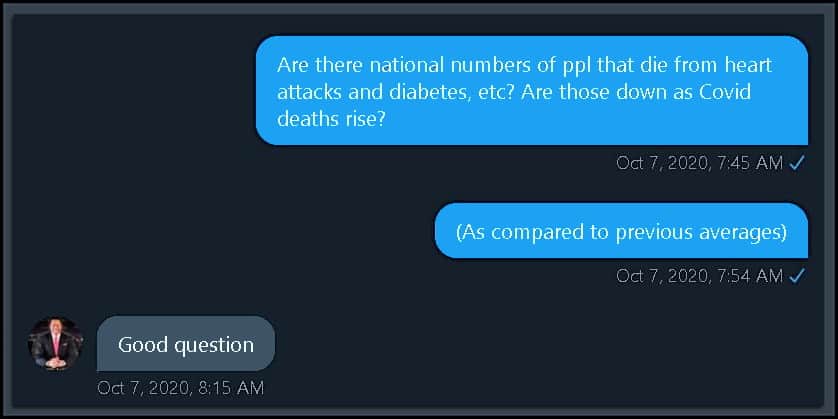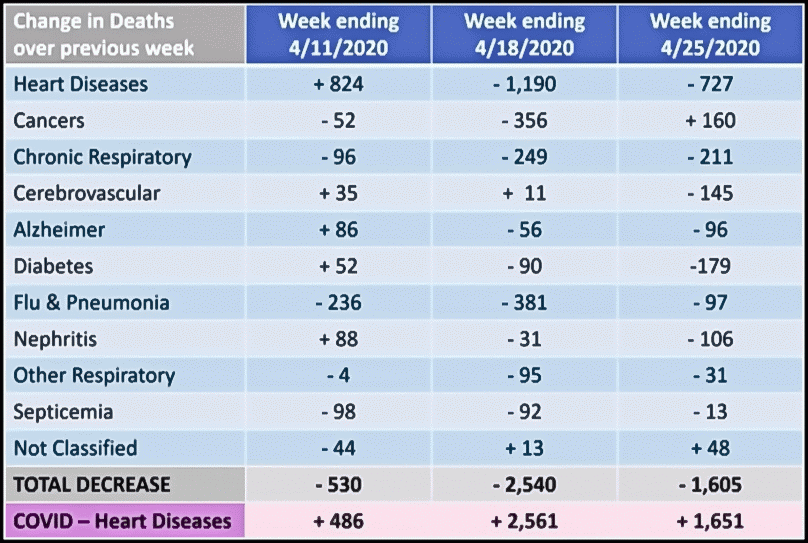A month or two ago I asked a question about the average death by heart-attack, diabetes, and other ailments that affect the population… what the average of those deaths each year were from year to year, and, if we would see a decrease of deaths by what is a normal average from year-to-year – compared to 2020.
Here is a message I sent to LARRY ELDER October 7th
In other words, since what would normally be deaths spread across a wide spectrum year in and year out would decrease this year because hospitals are categorizing (for the first time in the history of medicine) these deaths as Covid-19. [Whereas previous outbreaks of “novel” and “regular” influenza were never categorized with “co-morbidities.] I assume that if these previous outbreaks were coupled with – at the time of death – these co-morbidities… I suspect the numbers below would be tripled or quadrupled:
[1] The 1918-19 “Spanish Flu” Pandemic — 675,000 died in the United States, some victims died within mere hours or days of developing symptoms.
[2] The 1957-58 “Asian Flu” Pandemic — 116,000 deaths were in the US. Most of the cases affected young children. (U.S. population in 1957 177,751,476)
[3] The 1968-69 “Hong Kong Flu” Pandemic — 100,000 deaths occurred in the United States. (In 1969 the U.S. population was 207,659,263)
[4] 2017-2018 flu season — The CDC estimates that between 46,000 and 95,000 Americans died due to influenza during the 2017-18 flu season. This resulted in an estimated 959,000 hospitalizations and a middle-ground of 61,099 deaths.
[5] 2012-2013 flu season — 56,000 deaths is the CDC estimate. 571,000 influenza-related hospitalizations
[7] 2014-2015 flu season — 591,000 influenza-related hospitalizations, and 51,000 flu-associated deaths
Well, there is an answer to my query… and it was published for a short while… then yanked per “pressure.” Here is the “set up” via PJ-MEDIA:
Conventional wisdom is that COVID-19 has caused thousands of deaths in the United States and nearly 1.5 million worldwide. This perception has been directly challenged by a study published by Johns Hopkins University on November 22.
Genevieve Briand, assistant program director of the Applied Economics master’s degree program at Johns Hopkins University, critically analyzed the impact that COVID-19 had on U.S. deaths. According to Briand, the impact of COVID-19 on deaths in the United States can be fully understood by comparing it to the number of total deaths in the country.
According to the study, “in contrast to most people’s assumptions, the number of deaths by COVID-19 is not alarming. In fact, it has relatively no effect on deaths in the United States.”
Wait, what? Really?
That’s what it says. And, it should come as no surprise that the study was deleted within days.
Luckily, a back-up copy remains on The Wayback Machine, and we can still read the study…
[….]
The study foun0d that “This trend is completely contrary to the pattern observed in all previous years.” In fact, “the total decrease in deaths by other causes almost exactly equals the increase in deaths by COVID-19.”
Briand concludes that the COVID-19 death toll in the United States is misleading and that deaths from other diseases are being categorized as COVID-19 deaths……
(emphasis added)
Here is the portion excerpted from Johns Hopkins by PJ-MEDIA:
After retrieving data on the CDC website, Briand compiled a graph representing percentages of total deaths per age category from early February to early September, which includes the period from before COVID-19 was detected in the U.S. to after infection rates soared.
Surprisingly, the deaths of older people stayed the same before and after COVID-19. Since COVID-19 mainly affects the elderly, experts expected an increase in the percentage of deaths in older age groups. However, this increase is not seen from the CDC data. In fact, the percentages of deaths among all age groups remain relatively the same.
To answer that question, Briand shifted her focus to the deaths per causes ranging from 2014 to 2020. There is a sudden increase in deaths in 2020 due to COVID-19. This is no surprise because COVID-19 emerged in the U.S. in early 2020, and thus COVID-19-related deaths increased drastically afterward.
Analysis of deaths per cause in 2018 revealed that the pattern of seasonal increase in the total number of deaths is a result of the rise in deaths by all causes, with the top three being heart disease, respiratory diseases, influenza and pneumonia.
When Briand looked at the 2020 data during that seasonal period, COVID-19-related deaths exceeded deaths from heart diseases. This was highly unusual since heart disease has always prevailed as the leading cause of deaths. However, when taking a closer look at the death numbers, she noted something strange. As Briand compared the number of deaths per cause during that period in 2020 to 2018, she noticed that instead of the expected drastic increase across all causes, there was a significant decrease in deaths due to heart disease. Even more surprising, as seen in the graph below, this sudden decline in deaths is observed for all other causes.
A friend commented (“Make it simple. 7700 died everyday on average in 2017. 2020?”), which got me thinking and searching. I found a really good convo kinda correcting a main post… here is the comment I thought was most thoughtful/fact filled:
There is a HUGE factor omitted from all of these “excessive death” numbers which is the way that the “excessive death” numbers have been trending over the last decade in the US.
This year is decidedly NOT an aberration.
For the US, the Macrotrends site below estimates 8.88 deaths per 1,000 residents for 2020, which would be about 3 million deaths of all causes for Jan. 1 to Dec. 31 of this year. The chances of the “Coronavirus epidemic” pushing that figure noticeably up, in a way such that someone at a distant time or place glancing at a table of deaths for a long period would immediately notice, appears to now be zero. Though I am sure most people will still vaguely think it is a major threat of exactly that kind, owing to the pro-Panic side’s control of the media narrative.
On total deaths in the 2010’s in the US.
The low-period for deaths per capita in the US was 2008 to 2013 (rate: 8.12 to 8.16 range). Looking at deaths since then (2013 to 2019):
US Deaths per 1000 residents:
– 2013: 8.159
– 2014: 8.264
– 2015: 8.369
– 2016: 8.475
– 2017: 8.580
– 2018: 8.685
– 2019: 8.782
– 2020: (proj.) 8.880
US Census estimates for total resident population as of July 1 of each year (Census Table NST-EST 2019-01):
– 2013: 315,993,715
– 2014: 318,301,008
– 2015: 320,635,163
– 2016: 322,941,311
– 2017: 324,985,539
– 2018: 326,687,501
– 2019: 328,239,523
– 2020: 329,877,505
Multiplying the two we get an interesting result.
TOTAL DEATHS in the US:
– 2013 total deaths: 2,578,000
– 2014 total deaths: 2,630,500
– 2015 total deaths: 2,683,500
– 2016 total deaths: 2,737,000
– 2017 total deaths: 2,788,500
– 2018 total deaths: 2,837,000
– 2019 total deaths: 2,882,500
– 2020 total deaths (proj.): 2,929,500
Notice the substantial increase each year, absent any named, attention-getting, Panic-creating flu-virus event through the 2010s (some bad flu-strains existed but no one noticed/cared). 2019 had +146,000 more total deaths than 2016, for example, and even +304,500 (!) over 2013.
2020 was projected to have even more, +351,000 deaths over 2013, an estimate made before anyone knew about Coronavirus.
The basic mechanisms for these big-looking increases is no mystery, and nothing to panic about (of course):
- Aging population plus higher base population. Plus, some on the margins is due to the well-documented rise in so-called deaths of despair in Middle America, which includes drug-deaths; this part of the increase we SHOULD worry about, as certainly it is much more harmful than the current flu-virus pandemic, by any half-way objective measure. But about the rise of deaths of despair we hardly hear at all. No emergency measures, no martial law, hardly even any attention. Why?
Needless to say, the observed increase in deaths since 2013 far more than covers (exceeds) the total of number of deaths attributable to the 2020 coronavirus. The CoronaPanic-pushers of 2020 either do not know or don’t care about this. It qualifies as “Context,” which is a heresy to Corona True Believers.
Another comment mentioned the impact on our averages by the illegal immigrant population (22-million) impacting the death averages — mainly because they bring over the border poor health history which would imp[act them more during any large influenza season.
I also said in that original comment a month or-so-ago that IF these other causes of death dropped (heart disease, diabetes, etc) because of Covid-19, then, we should consider Covid-19 a positive that we would want to keep around. One should read the whole post by PJ-MEDIA… it is an excellent read in totality.
UPDATE
American Institute for Economic Research (AIER) has a bang-up article regarding the Johns Hopkins study discussing the average death rate from year to year. Some of the bove is repeated… but repeated well (hat-tip, ALPHA NEWS):
DIVING DEEPER
What is even more interesting if not more alarming is that the spike in recorded Covid-19 deaths seen in 2020 has coincided with a proportional decrease in death from other diseases.
Yanni Gu writes
“This suggests, according to Briand, that the COVID-19 death toll is misleading. Briand believes that deaths due to heart diseases, respiratory diseases, influenza and pneumonia may instead be recategorized as being due to COVID-19.”
Deaths have remained relatively constant, yet reported deaths due to deadly conditions such as heart disease have fallen while reported Covid deaths have risen. This suggests that the current Covid death count is in some capacity relabeled deaths due to other ailments. According to the graph, reported Covid deaths even overtook heart disease as the main cause of death at one point, which should raise suspicion.
This aligns with many other well-established facts about the virus, such as those with comorbidities are the most at risk. According to the CDC, about 94% of Covid deaths occur with comorbidities. This suggests that it could be possible that a large number of deaths could have been mainly due to more serious ailments such as heart disease but categorized as a Covid-19 death, a far less lethal disease.
According to this graph provided by the study, deaths labeled under Covid-19 increased while deaths labeled under others decreased. It is important to note that this sample only applies to the month of April as the author notes these were the weeks with the highest reported deaths. Gu writes
“The CDC classified all deaths that are related to COVID-19 simply as COVID-19 deaths. Even patients dying from other underlying diseases but are infected with COVID-19 count as COVID-19 deaths. This is likely the main explanation as to why COVID-19 deaths drastically increased while deaths by all other diseases experienced a significant decrease… “If [the COVID-19 death toll] was not misleading at all, what we should have observed is an increased number of heart attacks and increased COVID-19 numbers. But a decreased number of heart attacks and all the other death causes doesn’t give us a choice but to point to some misclassification,” Briand replied.”
Furthermore, Briand’s research notes that the percentage of death has remained relatively constant through all age groups. Covid death statistics seem to mirror the normal distribution of death amongst age groups, further lending credence to the argument that many Covid deaths are recategorized deaths.
Briand provides this graph constructed from CDC data that shows that deaths amongst various age groups have remained relatively constant.
By simply looking at the raw data presented by the CDC Gu writes that
“All of this points to no evidence that COVID-19 created any excess deaths. Total death numbers are not above normal death numbers. We found no evidence to the contrary,” Briand concluded…..


